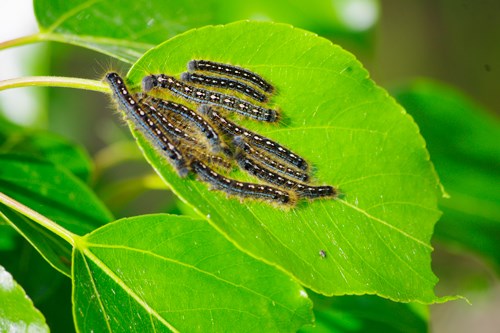They shuffle mutely throughout the city in search of food but they aren’t the brightest coins in the fountain and are particularly susceptible to being run over by cars. And while it might sound similar to a zombie apocalypse, it’s actually just a forest tent caterpillar outbreak, a natural part of the boreal forest life cycle.
If you don’t like creepy crawly critters, you may want to mind where you look or step when you’re outside in Thompson these days, as a large number of forest tent caterpillars are inching their way across the landscape and up the sides of buildings and trees in search of suitable food sources like the leaves of the trembling aspen, also known as the white poplar.
Dr. Terry Galloway, a professor in the entomology department of the University of Manitoba’s Faculty of Agricultural and Food Sciences and acting head of the department, says when the forest tent caterpillars – which are mainly dark brown with white spots and broad blue lines at maturity – start crossing roads and climbing walls they’re likely either getting ready to pupate or are in search of more food. At times, during particularly bad outbreaks, he said, there have been stories of trains having traction problems because the caterpillars crushed while crossing in the path of trains make the tracks so greasy and slippery.
“They’re really impressive when they get in that outbreak situation,” Galloway says.
The outbreak in Thompson began last year, says regional forester Bruce Holmes of Conservation Manitoba, and outbreaks in the north typically last for three years. He says the caterpillars seemed to be moving in search of new feeding areas when he was south of Thompson last week and their flattened bodies were discolouring the pavement on Highway 6.
Forest tent caterpillar populations wax and wane over a long cycle of about 10 to 12 years in the boreal forest, according to the Canadian Forest Service, and forest tent caterpillars defoliated 14.3 million hectares of trees in 2001, which was also the year of the last recorded outbreak in Manitoba.
“Forest tent caterpillar outbreaks are part of the natural cycle of the northern boreal forest and it is allowed to run its course, without control or mitigation,” says Holmes.
Manitoba Conservation’s forestry branch says population is controlled by various natural factors including high population levels and late spring frosts that destroy foliage and cause mass starvation, excessively high temperatures during the moth stage of the life cycle, and parasites like the flesh fly, which lays its eggs on forest tent caterpillar cocoons so maggots can burrow through the silken case to feed on the pupa inside. Some birds also feed on the caterpillars, says Galloway. Eventually, the numbers of predators and parasites go up and then the forest tent caterpillar population crashes.
“When things are favourable they build back up,” says Galloway, noting that the cycle of caterpillar outbreaks is not entirely predictable but that when one occurs the forest tent caterpillars will eat all of the vegetation off the types of trees that they like to eat, which also include other broad-leafed deciduous trees and shrubs. During a large outbreak, says Galloway, if you are out in the forest you can actually hear the frass, or insect excrement, raining down and hitting other vegetation on its way to the forest floor.
The caterpillars will probably start going into the cocoon stage sometime this week, says Holmes, and the trees they have fed on will begin growing new leaves. Generally speaking, even severe feeding does not kill the tree and new leaves grow back later in the season. After two or more consecutive years of severe feeding, tree health can decline and twigs and branches may die off. Three or four years of being stripped of their leaves can make trees more susceptible to other insects and stem disease.
The moths that emerge in late July to early August are light brown with a 30- to 45-millimetre (11/4 to 13/4 inch) wingspan and two darker bands across the forewing. They lay 150 to 200 grey eggs in five- to 15-mm wide bands that encircle twigs and may be covered with a shiny protective substance called spumaline. The moth stage of the lifecycle typically lasts around five to 10 days. The caterpillars develop within three weeks of the eggs being laid but spend the winter inside the egg and emerge in the spring when buds begin to develop on their favourite food trees.




